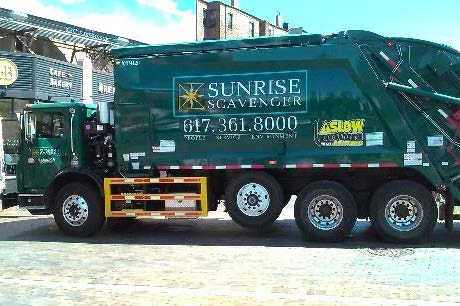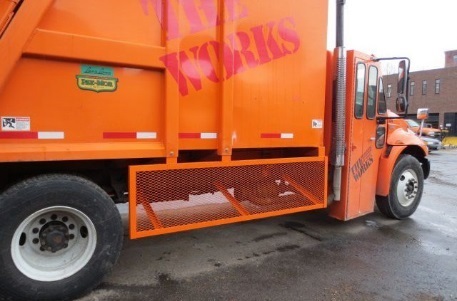Truck Side Guard Ordinance: Boston, MA
Printable Version [PDF, 405 KB]
You may need the Adobe® Reader® to view the PDFs on this page.
Contact Information: Freight Feedback at FreightFeedback@dot.gov

U.S. Department of Transportation
Federal Highway Administration
Office of Operations
1200 New Jersey Avenue, SE
Washington, DC 20590
FHWA-HOP-16-081
March 2017
Description
In October 2014, the Boston City Council passed the nation’s first truck side guard ordinance, which requires that enhanced safety measures (side guards, convex mirrors, cross-over mirrors, and blind-spot awareness decals) be installed on all city-owned and city-contracted motor vehicles weighing over 10,000 lbs. and semi-trailers exceeding 26,000 lbs. The intent of these requirements is to reduce the number of bicycle and pedestrian fatalities caused by collisions with trucks, in part by encouraging private companies operating large trucks in the city to adopt these safety measures voluntarily. (More information on Boston’s ordinance is available at: http://goo.gl/NFBLeM)
Process
In 2012, five fatal cycling collisions occurred in the city of Boston, four of which involved a truck or bus. Two were broadside crashes. In early 2013, the Mayor’s Office of New Urban Mechanics and the Public Works Department consulted with the U.S. Department of Transportation Volpe Center and decided to pilot three different types of truck side guards to mitigate such crashes, using 17 vehicles from the city’s own fleet. Installing side guard equipment costs about $1,800 per truck, and they can last the lifetime of the vehicle.
For the pilot, three different side guard models were installed—steel rail, steel mesh, and Airflow Deflector, a polymer composite material. Rail and mesh models were custom fabricated by Massachusetts manufacturers while the Airflow Deflector was an off-the-shelf product. The pilot demonstrated that it is possible to remove the side guards to service the vehicles, that vehicles can still mount curbs, and that vehicles will not become stuck in snow or debris. The city tested and collected data for over a year, ultimately choosing the Airflow Deflector model because it is commercially available, can be easily cut to size to fit each truck, and can be removed easily with few tools.
KEY ACCOMPLISHMENTS
- Largest municipal pilot of side guards in the nation.
- First U.S. city ordinance to require sideguards and cross-over mirrors.
- Currently over 80 vehicles outfitted with sideguards through this effort.
- Bicyclist struck by city-contracted truck equipped with side guards survived crash.
In March 2014, the city’s new trash collection contract bid included a provision that each vehicle have side guards installed. However, the city did not include the exact specifications for the guards, complicating the implementation process. Today, side guards are installed on nearly all city-contracted trash trucks with a few exceptions, such as trucks on which side guards would interfere with hydraulics. City-owned trucks that frequent high-volume pedestrian and cyclist areas in Boston’s downtown core have extra flashing lights and awareness decals attached.
In April 2014, a privately operated trash truck in the Charlestown neighborhood of Boston struck and killed a cyclist. Martin Walsh, the newly elected mayor of Boston, took notice. He wanted to learn more about expanding the adoption of truck side guards, including legislation. The city drafted an ordinance requiring vehicles that contract with the city to install side guards, blind-spot mirrors, cross-over mirrors, and necessary awareness decals. The ordinance went before the City Council and passed unanimously in October 2014, taking effect in May 2015. (Ordinance full text: http://goo.gl/ScSklB)
There are a few exceptions to the ordinance. Trucks in certain categories such as snow removal vehicles, street sweepers, and emergency vehicles are exempt from the requirements. A truck that already has a toolbox installed where side guards would be installed will meet the requirements and pass inspection if the toolbox meets side guard specifications.
Boston’s Inspectional Services Department (ISD) is the enforcement agency for the truck side guard program. The program falls under the Weights and Measures Division. They trained and dedicated two inspectors to side guard inspections. ISD also created a video walk-through of a truck side guard inspection so that potential vendors know what to expect. (Watch the video: https://youtu.be/VBl22ctIEWI)
 Airflow Deflector Side Guard |
 Steel or Aluminum Rail Side Guard |
 Steel Mesh Side Guard Steel |
Since the ordinance went into effect in May 2015, the city has undertaken outreach and educational efforts with current vendors with large trucks, focusing on educating contractors before punishing them for noncompliance. To help spread the word about this new ordinance, the city has shared flyers and the video of a side guard inspection with several large State trucking organizations, conducted mass mailings to firms submitting bids, and followed up with the primary point of contact for each vendor.
As for next steps, the city’s near-term priorities include continuing to reach out and educate. In the longer run, the city plans to focus on stronger enforcement to increase compliance.
Lessons Learned and Recommendations
City of Boston staff realized throughout this process that it is a challenge to implement this type of policy at the local level. City government has limited authority over trucks operating within the city other than enforcement through local contracts. The mayor is currently working with State legislators to establish truck side guard requirements throughout the Commonwealth of Massachusetts. To local jurisdictions seeking to implement a truck side guard requirement, the city recommends:
- Leading by example by piloting side guards on a city fleet.
- Requiring side guards and safety mirrors in contracts for city services. Reference the Volpe national sideguard standard for exact specifications, available here: https://goo.gl/1dIoPu.
- Replacing a commercially available product after a crash is easier than replacing a custom-built product. Private companies are also more likely to adopt an existing product rather than build a customized solution.
Local Contacts:
Kris Carter
Mayor’s Office of New Urban Mechanics
kristopher.carter@boston.gov | (617) 635-2275
Indira Alvarez
Inspectional Services Department (ISD)
indira.alvarez@boston.gov | (617) 961-3310
For more information, contact:
Tamiko Burnell
Freight Specialist
Tamiko.Burnell@dot.gov 202-366-1200
or FreightFeedback@dot.gov